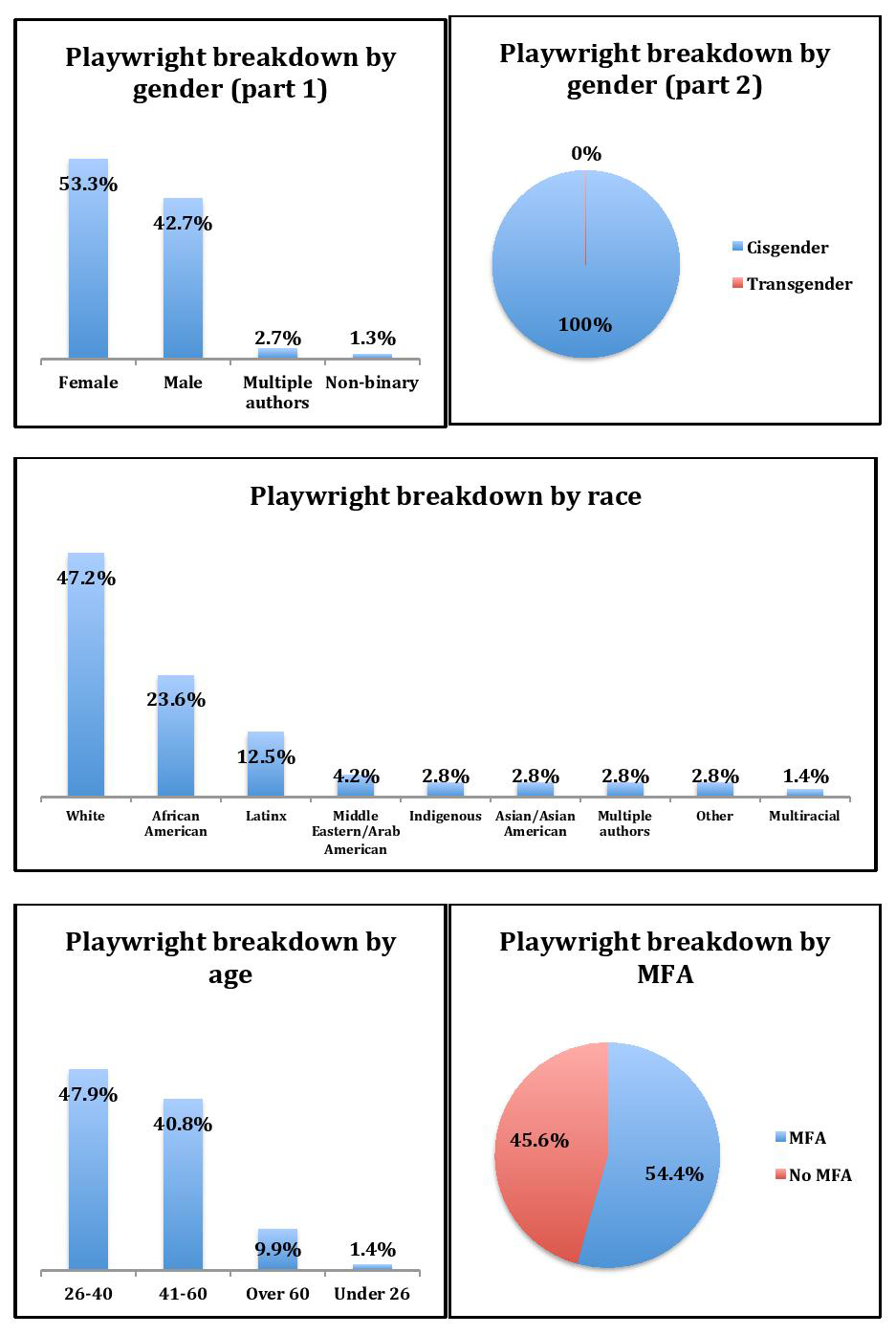Community, Leadership, Experimentation, Diversity, & Education
Pittsburgh Arts, Regional Theatre, New Work, Producing, Copyright, Labor Unions,
New Products, Coping Skills, J-O-Bs...
Theatre industry news, University & School of Drama Announcements, plus occasional course support for
Carnegie Mellon School of Drama Faculty, Staff, Students, and Alumni.
CMU School of Drama
Wednesday, October 23, 2019
What Our New Plays Really Look Like
HowlRound Theatre Commons: The goal of this study is to use data to capture trends in new play production at the seventy-five LORT (League of Resident Theatres) member theatres and the thirty-two NNPN (National New Play Network) core member theatres. In working, I set out to answer three questions: Who is being produced on our stages? What kinds of characters are appearing on our stages? And what do these plays look like in terms of form and thematic content? By measuring where new play production is currently at, I hope to create an awareness of not only what is happening on our stages but also what is missing from them.
Subscribe to:
Post Comments (Atom)

4 comments:
This is a really interesting and cool study. Capturing trends of new play production is something really relevant to the current world of art we live in. Looking for new ideas and looking to see what is actually being produced from those new ideas is smart. The author of this article is right in looking at what is happening, but also recognizing what we’re missing in our current world of new work. It frustrates me to no end that we still live in a world where there is an absence of trans and non-binary voices in a theatrical season. Theatre is about telling stories for those that need them. And everyone has a story. So why aren’t we producing a story for every perspective of person that exists? It’s total bullshit. Theatre dances around this idea that it needs to remain popular for the masses. But if you bring in plays that are not all about cis-people, than you’re widening your target market. You’re inviting a bigger audience to the table.
This study is so intriguing and relevant. The evidence and statistics really gave me a partial insight into where the theatre industry is right now. The study was very in-depth and covered a lot of areas! Similar to the author, I was pleasantly surprised that of the sample size, 53.3% of the plays were written by female playwrights. Diversity has also moved forward, with 57.7% of plays where at least half of the characters are non-white. But it was eye opening too to see some of the more worrying results. Of 111 plays, only 1.3% of the playwrights identified as non-binary. Moreover, only 6.7% of plays contained transgender characters. On the surface, the industry has become more diverse but if you look at the specifics, we have a lot more work to do. What troubled me the most was the alarming small numbers for representation of minorities groups. Only 13% of plays featured AT LEAST ONE asian or Asian American character. 7.2% for indigenous characters. This lack of representation mirrors society’s climate with minorities. They are often forgotten, ignored or treated as an afterthought. While theatre and entertainment has made huge strides in becoming more diverse, there are people that still need to be included more. Echoing off of Ella's comment above, storytelling would really benefit from expanding perspectives, including more people. You would widen your market and make more people want to see your play.
I really appreciate that people put the time and effort into doing studies like this. Dramaturgs are really out there doing the important work! Another thing I think would have been interesting to consider in this study is the racial, sexual, and gender demographics of members of these theaters compared to the diversity shown in the new works produced in each company. The information that Marshall Botvinick is really eye opening because it really challenges my idea of the direction that professional theater is moving in. It is really interesting to me that approximately 57% of the plays produced that fall into the category of this study have casts in which at least half the parts are specified as being non-white because I think it shows what we are coming to value in theater as a community: true stories that represent all ethnicities and cultures and have a bearing on the real world so that people can see other's stories and understand their place in the world.
I'm so glad to see articles like this! This is one of the more comprehensive yet concise research pieces I've seen that really senses the pulse of theatre in today's climate. Visually seeing how Race, Politics, #MeToo, and Mental Illness top the list of new works helps understand what this industry is setting out to do. Some of the other pieces of data, such as intermissions, realism, and location also reveal a trend about what audiences are preferring out of a theatrical experience. There are, of course, troubling numbers, particularly with regards to the transgender and gender identities of characters and performers. Our industry has always sought out to fight for LGBTQ+ rights, yet it is clear we need to be doing more. Part of this, I believe, is a top-down issue since many producers and artistic directors don't represent these individuals, since they had the opportunity to rise through the ranks while many gender identities were suppressed. My hope is that if we continue the progress we are making, slowly but surely many of these unrepresented groups will fill these positions of influence.
Post a Comment